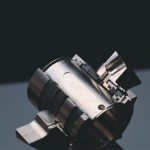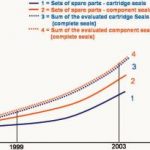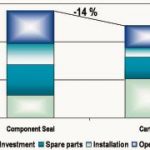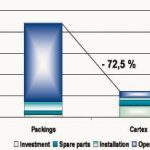Mechanical seals influence the MTBF rate and life-cycle of pumps to a considerable extent, and can thus make a key contribution to achieving reliable and economically efficient operation of an industrial plant. Modern cartridge-type mechanical seals may help to reduce life cycle costs and raise MTBF rates.
Dipl.-Ing. Dieter Ziegenbein
The analysis of an average chemical plant as described in [1] shows that approximately 20 % of the total investment is accounted for the pump technology, while the mechanical seals included in that figure account for what is merely a minute proportion of just a few percent. An extract from this study clearly substantiates the fact that the installation and removal times taken up by repair work on mechanical seals in pumps, together with downtimes and, in turn, loss of production are of much greater significance than the pure seal acquisition costs.
In the interests of reducing plant downtimes and the resultant loss of production mechanical seals – as weak point in the pumps – need to have their MTBF figures improved. Due to the extremely low proportion of the total investment accounted for by mechanical seals, the investment in a higher-quality sealing system (Fig. 1) with a longer average service life only has an insignificant impact on the total cost of the plant. A precise analysis of pump failures is an absolute necessity in the interests of being able to exert a positive influence on the MTBF rate.
Causes of pump failure
Such analyses in the case of, for example, OMV Austria and InfraServ, Gendorf, show that there are two predominant causes of pump failure and the resultant high costs. On the one hand there is the mechanical seal, which the OMV analysis [2] shows to account for a proportion of approximately 40 %, and, on the other, incorrect operation and running of pumps, accounting for around 45 % of cases according to the InfraServ study [3]. Other components, such as impeller (3 %), coupling (15 %), bearing (15 %) or housing (3 %) are of less importance. A further analysis (Fig. 2 [4]) provides information on the average service life of individual key pump components. The chart shows that in this case too, the weakest link in the chain is the mechanical seal with an average service life of 1.2 years. The component with the second shortest average service life (3 years) are the bearings. It is therefore a logical step to raise the average service life of the mechanical seals to that of the bearing. According to this averages-based study, approximately every second pump repair and the resultant downtimes and losses of production can be avoided by successfully increasing the service life of the mechanical seal. In the interests of positively influencing the LCC (life cycle costs) it is essential to find the optimum degrees in terms of investment in mechanical seals and increasing their service life. Inadequate investment in the mechanical seal system leads to a shortened service life in comparison with the bearing, while excessive investment increases the LCC level to an undesirable degree.
Analysing the sealing systems
As substantiation which sealing system is capable of achieving the required raising of the MTBF rate Burgmann ran a secondary analysis of several customer-operated plants via their Sepro service program. The evaluation period of this analysis was five years. Identical numbers of component seals and cartridge seals in operation were recorded for the purposes of this analysis, and the associated consumption of spare parts over the same period was determined. As figure 3 shows, the consumption of spare parts for the component seals was considerably greater than for the cartridge seals. The lower level of spare parts consumption relating to the cartridge seals under review is a clear indication of their longer average service life in comparison to component seals. Long-term studies performed in the central pump workshop at BASF Ludwigshafen arrived at the same results [5]. With these facts, it can be concluded that cartridge-type mechanical seals contribute considerably towards reducing LCC and raising MTBF rates. This effect can be further enhanced by the use of innovative technology.
Comparing economic efficiency
Remarkably, the two following analyses of economic efficiency compare the overall costs of a cartridge-type mechanical seal with those of a component seal first and then with those of a packing. These analyses take account of all relevant costs accumulating as in the above definition of LCC. The savings that can be made by using a Cartex cartridge seal as opposed to a component seal amount to 14 % and to 72 % as opposed to packings (Fig. 4 and Fig. 5). Significant savings amounting to 14 % can be made with a cartridge seal in spite of the fact that the investment costs it involves are higher than those for a component seal. In the three-year period shown, this savings are in particular attributable to the cartridge seal’s longer service life and the fact that it is quicker to install. The costs of spare parts for the component seal are not only affected by the higher rate of wear of a seal under load, but also by the necessity to replace shaft sleeves damaged by dynamic O-rings. For the cost comparison with packings the economic analysis covers a period of three years as well. The significant savings in operating costs largely result from considerably lower power consumption and massive reductions of leakage in comparison to the packing. The advantage that spare parts for packings are less expensive is cancelled out by the disadvantages of their shorter service life, the damage they cause to shaft sleeves and the costs entailed in their installation and disassembly. The economic advantages enabled by the cartridge seal over packings are even greater than in the comparison between cartridge unit and component seal.
Effect of design
What is known as the stationary design is achieved by reversing the conventional mechanical seal structure, i.e. stationary seat and rotating seal face. This means that the seat rotates, the seal face is arranged in a stationary manner and the springs are located outside of the product. The key consequence of this method of construction is the absence of a dynamic O-ring on the shaft since it is now stationary in the seal cover. The main advantage of the stationary design therefore lies in the flexibility of the stationary seal face which can now adapt itself immediately in the case of shaft misalignment caused by assembly tolerances or shaft deflection. The O-ring at the seal face is no longer subject to loading at every rotation of the shaft as result of axial compensation. A fretting damage to the pump shaft sleeve due to the dynamic O-Ring is now effectively prevented. This protection against wear of the shaft sleeve plays a very considerable role in the results of the above analysis of economic efficiency since it makes regular replacement of the shaft sleeve unnecessary. Furthermore, the time needed to install a cartridge seal is significantly less (approximately 2/3) than for a component seal, which requires extensive measurement for positioning the rotating unit on the shaft. Testimony to this effect, and thus substantiation of the cartridge philosophy, was provided by BASF Ludwigshafen, where cartridge seals can be replaced directly on-site in the processing plant whereas component seals all have to be changed in the central pump workshop. The setting up of a new cartridge pool with its own storage facilities and service point as well shows that large-scale industrial production companies have recognized the advantages of using cartridge seals.
Literature
- 1. Sealing Technology – BAT guidance notesESA Publication No. 014/04, Draft 04, January 2004
- 2. OMV AG, Pumpen in der Verfahrenstechnik, 2002
- 3. Aus Sicht der Instandhaltung – InfraServ, Gendorf cav 12/2000
- 4. 17th International Pump User Symposium, Houston
- 5. Dr. Ing. Hennecke, former chief of central pump workshop, BASF Ludwigshafen
cpp 402
Features of cartridge seal
A cartridge seal is a component seal with its own cover, preassembled and positioned on the shaft sleeve. Cartridge seals unite the following benefits and advantages by way of the concept alone:
- greater functional reliability due to preassembled seal
- no measurement errors can occur as they do with component seals
- the entry of dirt or damage to the sliding faces during installation is prevented
- preassembled unit means less installation costs
- less plant downtime during installation
- protection of the pump shaft / shaft sleeve as no dynamic O-ring could damage the shaft and cartridge seals have their own shaft sleeve
- reduced power consumption as compared with packings and mechanical seals under load
Share:











